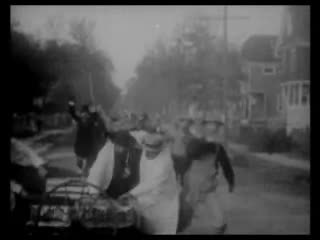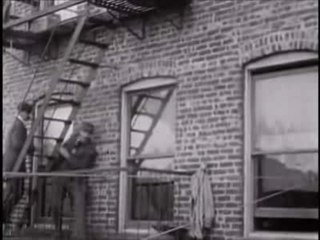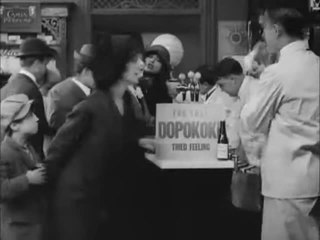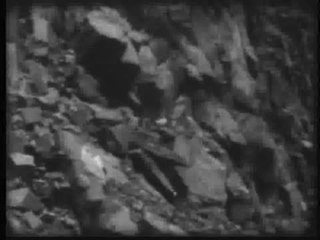Related Research Articles

The Taming of the Shrew is a 1908 silent film directed by D. W. Griffith and produced by the American Mutoscope and Biograph Company of New York City. The 17-minute short, which is based on the play of the same name by English playwright William Shakespeare, was filmed in just two days–October 1 and 7, 1908–at Biograph's studio in Manhattan and on location in nearby Coytesville, a borough of Fort Lee, New Jersey.
At the Altar is a 1909 American silent drama film directed by D. W. Griffith. The film was shot in Fort Lee, New Jersey where early film studios in America's first motion picture industry were based at the beginning of the 20th century. A print of this film is in the film archive of the Library of Congress.

The Curtain Pole is a 1909 American comedy film directed by D. W. Griffith. A print of the film still exists. The film was made by the American Mutoscope and Biograph Company when it and many other early film studios in America's first motion picture industry were based in Fort Lee, New Jersey at the beginning of the 20th century.

The Lonely Villa is a 1909 American short silent crime drama film directed by D. W. Griffith. The film stars David Miles, Marion Leonard and Mary Pickford in one of her first film roles. It is based on the 1901 French play Au Téléphone by André de Lorde. A print of The Lonely Villa survives and is currently in the public domain. The Lonely Villa was produced by the Biograph Company and shot in Fort Lee, New Jersey. It was released on June 10, 1909, along with another D.W. Griffith split-reel film, A New Trick.
After Many Years is a 1908 American silent drama film directed by D. W. Griffith. Prints of the film exist in the Library of Congress film archive. The film is an adaptation of Enoch Arden.

Rescued from an Eagle's Nest is a 1908 American silent action-drama film produced by Edwin S. Porter for Edison Studios and directed by J. Searle Dawley. It features the first leading screen role of the legendary American filmmaker D. W. Griffith, whose directorial debut was released just six months after he performed in this production. Griffith's casting in the Edison "photoplay" began when he found himself stranded and broke in New York City after a play he authored had failed. Desperate for money, he responded to Edison's offer to pay $15 to anyone who submitted a useable treatment or scenario based on the Puccini opera Tosca. Porter rejected Griffith's submission, but the studio executive did offer him the lead role in Rescued from an Eagle's Nest. A full print of this film survives in the extensive collection of moving images at the Museum of Modern Art. Only one other film in which Griffith appears as an actor survives.

The Battle is a 1911 American silent war film directed by D. W. Griffith. The film was set during the American Civil War. It was shot in Fort Lee, New Jersey, where many early film studios in America's first motion picture industry were based at the beginning of the 20th century. Prints of the film survive in several film archives around the world including the Museum of Modern Art, UCLA Film and Television Archive, George Eastman House, and the Filmoteca Española.
A Feud in the Kentucky Hills is a 1912 American silent drama film directed by D. W. Griffith. The film, by the Biograph Company, was shot on the Hudson Palisades near Fort Lee, New Jersey when many early film studios in America's first motion picture industry were based there at the beginning of the 20th century. Additional filming took place in and around the Pike County town of Milford, Pennsylvania.
The One She Loved is a 1912 American silent drama film directed by D. W. Griffith. The film, by the Biograph Company, was shot in Fort Lee, New Jersey when many early film studios in America's first motion picture industry were based there at the beginning of the 20th century.
The Voice of the Child is a 1911 American drama film directed by D. W. Griffith and starring Blanche Sweet. The film was made by the American Mutoscope and Biograph Company when it and many other early film studios in America's first motion picture industry were based in Fort Lee, New Jersey at the beginning of the 20th century.

Money Mad is a 1908 American short crime film directed by D. W. Griffith. It is based on the short story "Just Meat" by Jack London.
To Save Her Soul is a 1909 American short silent drama film directed by D. W. Griffith and starring Mary Pickford. The film was shot in Fort Lee, New Jersey when many of the early film studios in America's first motion picture industry were based there at the beginning of the 20th century.

The Miser's Heart is a 1911 American short silent drama film directed by D. W. Griffith and starring Blanche Sweet. The film was shot in Fort Lee, New Jersey where early film studios in America's first motion picture industry were based at the beginning of the 20th century. A print of the film survives.

The Eternal Mother is a surviving 1912 American short silent drama film directed by D. W. Griffith and starring Blanche Sweet. The film was shot in Fort Lee, New Jersey when Biograph Company and other early film studios in America's first motion picture industry were based there at the beginning of the 20th century.

For His Son is a 1912 American short silent drama film directed by D. W. Griffith and starring Blanche Sweet. The film was shot in Fort Lee, New Jersey when Biograph Company and other early film studios in America's first motion picture industry were based there at the beginning of the 20th century. A print of the film survives today.

The Italian Barber is a 1911 short silent drama film directed by D. W. Griffith, starring Joseph Graybill and featuring Mary Pickford. The film, by the Biograph Company, was shot in Fort Lee, New Jersey when many early film studios in America's first motion picture industry were based there at the beginning of the 20th century.
The Fight for Freedom is a 1908 American black-and-white short silent Western film which may have been directed by D. W. Griffith. Filmed in Shadyside, New Jersey in June 1908, the film was released on July 17, 1908.
The Tavern Keeper's Daughter is a 1908 American silent action film directed by D. W. Griffith. The film was shot in Fort Lee, New Jersey when many early film studios in America's first motion picture industry were based there at the beginning of the 20th century.

The Black Viper is a 1908 film directed by D. W. Griffith. The film was made by the American Mutoscope and Biograph Company which was based in Fort Lee, New Jersey at the beginning of the 20th century.
The Fatal Hour is a 1908 American silent short crime film directed by D. W. Griffith.
References
- ↑ "Progressive Silent Film List: Balked at the Altar". Silent Era. Retrieved April 30, 2008.
- ↑ Koszarski, Richard (2004), Fort Lee: The Film Town, Rome, Italy: John Libbey Publishing -CIC srl, ISBN 0-86196-653-8